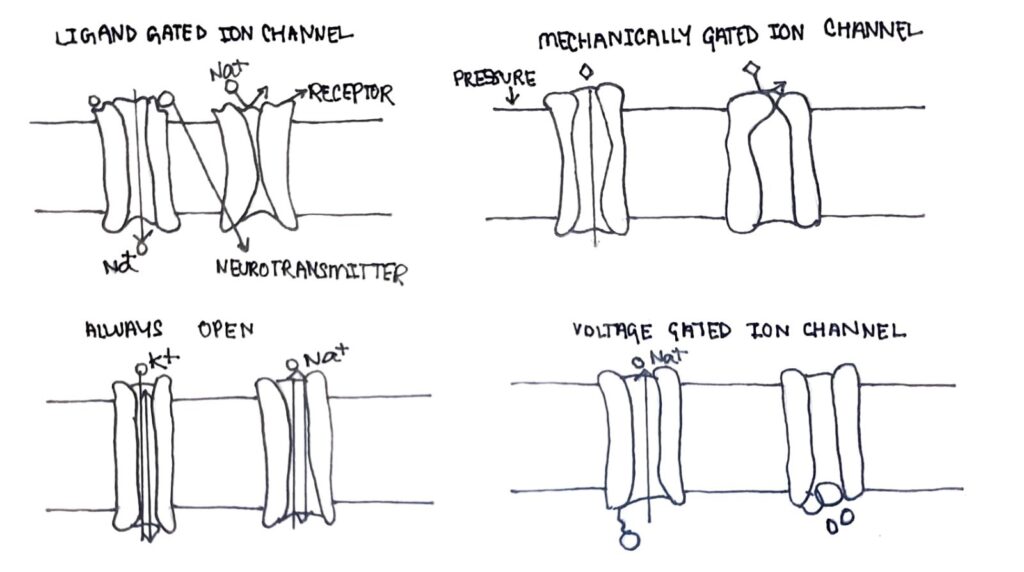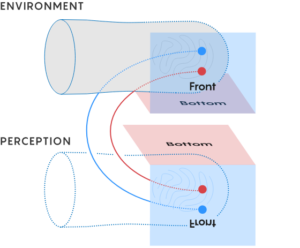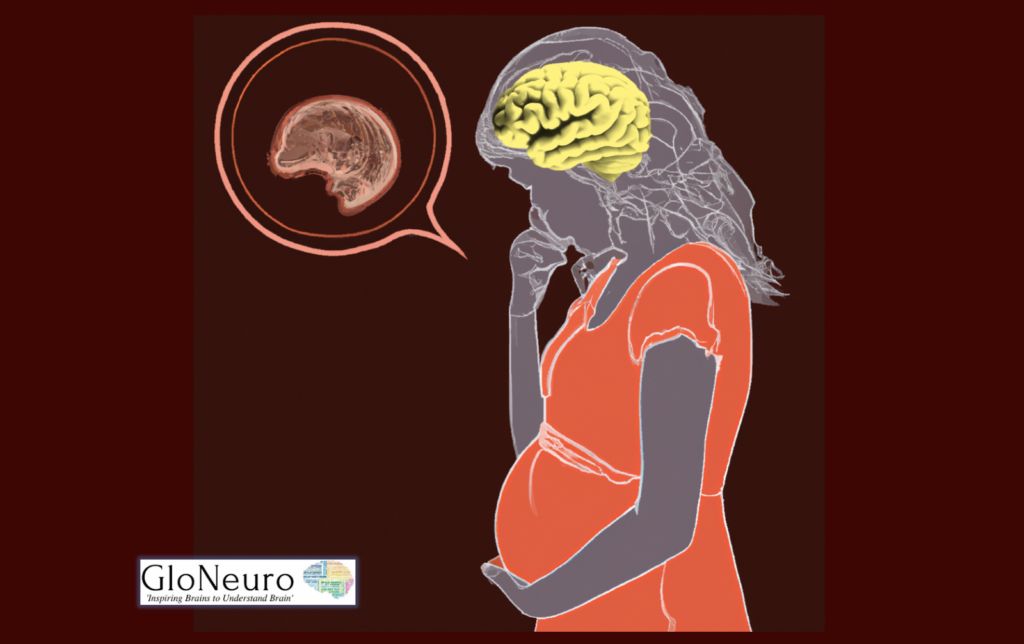December 21, 2023
Author: Sahil Sahu
Editor: Manish Verma
Summary: Ion channels are the molecular gatekeepers of health. They are crucial molecular entities, that regulate the flow of ions across cell membranes, playing a pivotal role in maintaining cellular health and are implicated in various diseases. Understanding their function offers insights into therapeutic interventions for a wide spectrum of health conditions.
Introduction:
Have you ever wondered how your heart beats, how your nerves fire, or how you taste your favorite pizza? Meet ion channels – the microscopic messengers orchestrating conversations between cells. Controlling the flow of electrically charged particles, they influence your thoughts and muscle movements. Imagine them as the conductors of a grand symphony, finely tuning the balance between health and disease.
But, as in any story, there’s a twist. Picture this: these normally well-behaved messengers sometimes go off-script, leading to unexpected health issues. Imagine a communication breakdown within your body’s orchestra, disrupting the harmonious rhythm. In this article we shall delve into the intriguing realm of these tiny yet powerful players, understanding how their occasional missteps impact our well-being. From sparking thoughts to orchestrating muscle contractions, their role is crucial, and so is comprehending the consequences when things go astray.
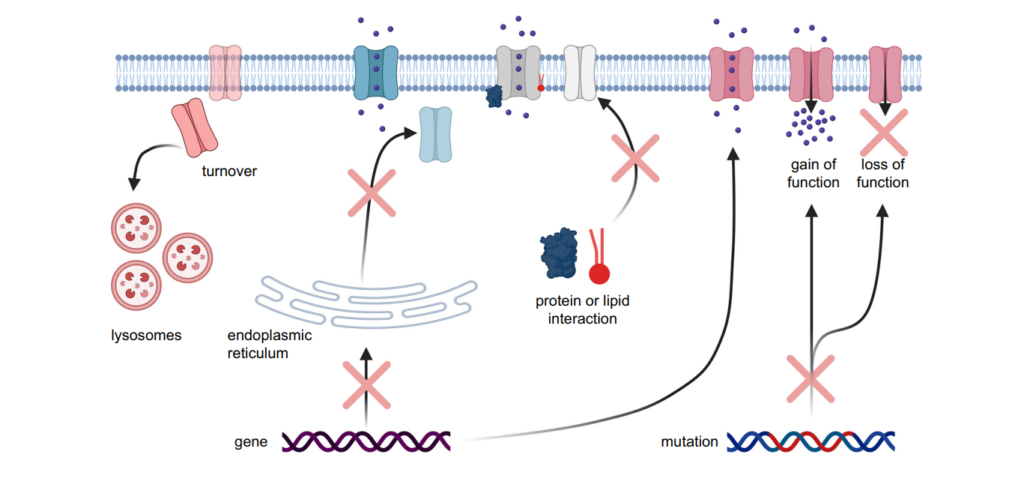
[source: Harraz et al., 2023]
Ion Channels in Health
Ion channels are essential membrane proteins that regulate the flow of ions across cell membranes, enabling vital physiological processes. Different types of ion channels, such as voltage-gated and ligand-gated channels, contribute to maintaining the balance of ions and electrical signals in the body.
Ion Channels are essential for our health because of the following reasons:
- Nerve signal transmission.
- Muscle contraction.
- Heart rhythm regulation.
- Cellular osmotic balance.
- Endocrine secretion.
Ion Channels in Diseases
Ion channels are present on both the plasma and nuclear membranes of every cell throughout the body. These specialized integral membrane proteins, categorized as channels, pumps, and transporters, create a barrier to the free movement of water and solutes. Disruption of a single gene or protein function can have severe consequences. Many human diseases, exemplified by harmful mutations in membrane proteins, are associated with these disruptions. Notably, there’s no inherent distinction between diseases caused by channels, pumps, or transporters; diseases can result from various functional defects, such as loss of function, gain of function, or trafficking defects. The term “channelopathies,” coined in 1993, specifically refers to disorders caused by disruptions in ion channels.
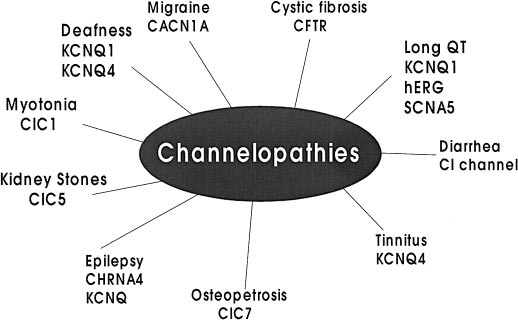
An exemplary disorder, Bartter syndrome, caused by inactivating mutations in genes encoding different membrane proteins, is grouped under the term “channelopathies.” Despite the variety of proteins involved, this classification helps identify diseases caused by defects in ion channels.
Different types of Channelopathies based on Substrates:

Hundreds of human genes encode ion channels, reflecting their diverse functions in the body. Ion channels are intimately involved in almost all aspects of physiology. Modulation or dysfunction of ion channels is linked to various diseases, including arrhythmias, cystic fibrosis, and epilepsy.
Future Directions
Ongoing discoveries continue to unveil new channelopathies and their impacts on human health. Advances in understanding the roles of ion channels in human physiology and pathophysiology contribute to this expansion of knowledge. Recent progress is attributed to a better understanding of ion channel functions and the effects of genetic variations. High-throughput genetic screens of large human populations contribute to identifying and understanding channelopathies.
Therapeutic Potential
Similar to G protein-coupled receptors, ion channels are recognized as crucial therapeutic targets. Examples include calcium channel blockers for hypertension and sodium channel blockers for epilepsy. Understanding channelopathies, whether genetic or acquired, provides potential avenues for therapeutic interventions. This understanding extends to changes in ion channels themselves or in interacting proteins or lipids, presenting diverse opportunities for intervention.
Conclusion
As research into channelopathies continues, our understanding of these complex diseases grows, leading to advancements in diagnosis, treatment, and potentially even cures. Continued exploration of these ion channels and their intricate functions holds immense promise for improving the lives of individuals affected by these diverse and often debilitating conditions.
References
- Hübner, C. A., & Jentsch, T. J. (2002). Ion channel diseases. Human molecular genetics, 11(20), 2435–2445. https://doi.org/10.1093/hmg/11.20.2435
- Litan, A., & Langhans, S. A. (2015). Cancer as a channelopathy: ion channels and pumps in tumor development and progression. Frontiers in cellular neuroscience, 9, 86. https://doi.org/10.3389/fncel.2015.00086
- The brain and behavior. Kandel E.R., & Schwartz J.H., & Jessell T.M., & Siegelbaum S.A., & Hudspeth A.J., & Mack S(Eds.), (2014). Principles of Neural Science, Fifth Edition. McGraw Hill. https://accessbiomedicalscience.mhmedical.com/content.aspx?bookid=1049§ionid=59138621
- Niemeyer, B. A., Mery, L., Zawar, C., Suckow, A., Monje, F., Pardo, L. A., Stuhmer, W., Flockerzi, V., & Hoth, M. (2001). Ion channels in health and disease. 83rd Boehringer Ingelheim Fonds International Titisee Conference. EMBO reports, 2(7), 568–573. https://doi.org/10.1093/embo-reports/kve145
- Niemeyer, B. A., Mery, L., Zawar, C., Suckow, A., Monje, F., Pardo, L. A., Stuhmer, W., Flockerzi, V., & Hoth, M. (2001). Ion channels in health and disease. 83rd Boehringer Ingelheim Fonds International Titisee Conference. EMBO reports, 2(7), 568–573. https://doi.org/10.1093/embo-reports/kve145
- Willumsen, N. J., Bech, M., Olesen, S. P., Jensen, B. S., Korsgaard, M. P., & Christophersen, P. (2003). High throughput electrophysiology: new perspectives for ion channel drug discovery. Receptors & channels, 9(1), 3–12.
- Harraz, O. F., & Delpire, E. (2024). Recent insights into channelopathies. Physiological reviews, 104(1), 23–31. https://doi.org/10.1152/physrev.00022.2023
Exploring the Therapeutic Symphony of Hypoalgesia and Music
Pain is a pervasive sensation experienced by 20% of the U.S. population every day, poses a major challenge, with prolonged or acute symptoms leading to negative health outcomes, increased health care utilization, and increased disability rates. Biologically, pain results from the activation of peripheral nociceptors and is modulated by a variety of inputs. Additionally, it is influenced by psychosocial factors such as anxiety, depression, and breakups. Effective pain management becomes increasingly complex as we navigate this complex landscape. Read more…

